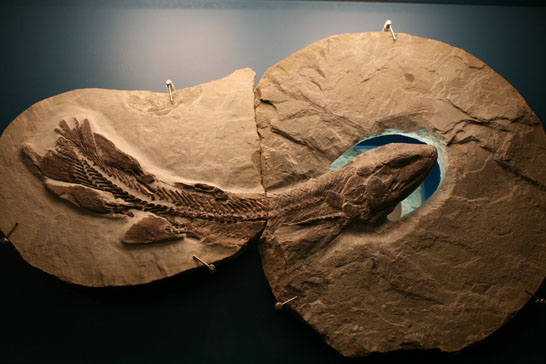Because the British were the most active in the early years, British names are predominant in the geological lexicon. Devonian is of course from the English county of Devon. Cambrian comes from the Roman name for Wales, while Ordovician and Silurian recall ancient Welsh tribes, the Ordovices and Silures. But with the rise of geological prospecting elsewhere, names began to creep in from all over. Jurassic refers to the Jura Mountains on the border of France and Switzerland. Permian recalls the former Russian province of Perm in the Ural Mountains. For Cretaceous (from the Latin for "chalk") we are indebted to a Belgian geologist with the perky name of J. J. d'Omalius d'Halloy.
在这门学科的早期,英国人是最活跃的,因此在地质词语中英国的名称占了绝大部分。泥盆系(即德文系)当然源自英格兰的德文郡。寒武纪来自罗马人对威尔士的叫法,而奥陶纪和志留纪使人想起了古代的威尔士人部落:奥陶人和志留人。但是,随着地质学后来在其他地方的崛起,世界各地的名称渐渐出现。侏罗纪跟法国和瑞士交界处的侏罗山有关。二叠纪使人想起俄罗斯乌拉尔山脉里的彼尔姆,而白垩纪(源自拉丁文白垩)是由一位比利时地质学家命名的,他自己也有个漂亮的名字,叫做J.J.德奥马利马斯·德霍洛伊。

Originally, geological history was divided into four spans of time: primary, secondary, tertiary, and quaternary. The system was too neat to last, and soon geologists were contributing additional divisions while eliminating others. Primary and secondary fell out of use altogether, while quaternary was discarded by some but kept by others. Today only tertiary remains as a common designation everywhere, even though it no longer represents a third period of anything.
原先,地质史分为4个时期:第一纪、第二纪、第三纪和第四纪。这个体系过于简单,因此寿命不太长。地质学家很快就用新的划分方法来替代这种划分方法。第一纪和第二纪已经完全不用,第四纪有的人已经不用,但有的人仍然在用。今天,只有第三纪还在广泛使用,虽然已经不代表第三纪任何东西。












